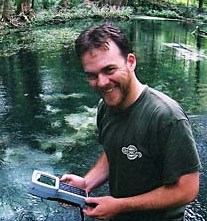We also found that city size influences whether or not the types of water bodies in cities are similar to those in surrounding undeveloped lands. In large cities, wetlands, ponds, and other shallow water bodies are present in about the same proportion as in their surroundings. But in smaller cities, these water bodies are generally absent. This pattern suggests that the processes that shape urban hydrography change as cities grow: initially, cities may be located in relatively dry land where building is easier, but as the urban footprint expands, alteration of water bodies may become more prevalent. What we don't know is how past and present protections for aquatic habitats may influence these patterns.
|
Meredith Steele's paper on the characteristics of urban water bodies in US cities has been published in this month's issue of Ecological Applications. Based on analysis of over 1 million water bodies in 100 US cities, we show that urban water bodies exhibit less variation in size than their counterparts in undeveloped lands, are generally less connected to surface channel networks, and that despite the presence of many unusually shaped water bodies in urban lands, they also tend to be more simply shaped. These patterns have implications for how urban water bodies interact with and respond to upland processes and act as habitat for biota.
We also found that city size influences whether or not the types of water bodies in cities are similar to those in surrounding undeveloped lands. In large cities, wetlands, ponds, and other shallow water bodies are present in about the same proportion as in their surroundings. But in smaller cities, these water bodies are generally absent. This pattern suggests that the processes that shape urban hydrography change as cities grow: initially, cities may be located in relatively dry land where building is easier, but as the urban footprint expands, alteration of water bodies may become more prevalent. What we don't know is how past and present protections for aquatic habitats may influence these patterns. |
Welcome!This is the homepage of the Heffernan Lab at Duke University. Here you can find all sorts of information about our research, teaching, and outreach. If you have any questions, contact Dr. Heffernan. Dr. Jim HeffernanI am an Assistant Professor in the Nicholas School of the Environment at Duke University. My research is focused on the causes and consequences of major changes in ecosystem structure, mostly in streams and wetlands. Archives
May 2018
Categories
All
|

 RSS Feed
RSS Feed
